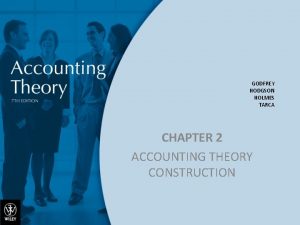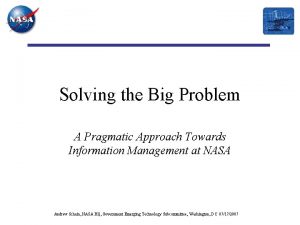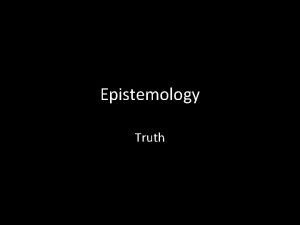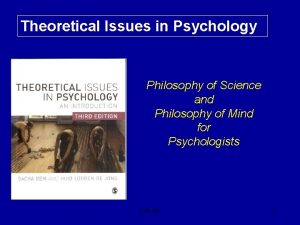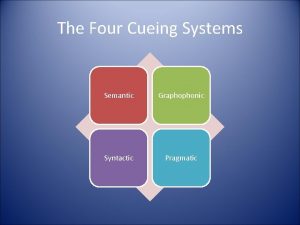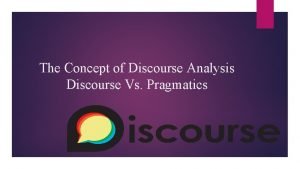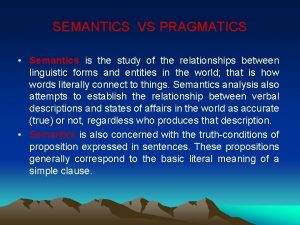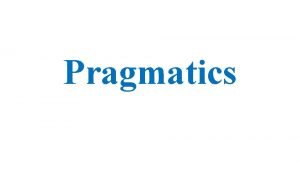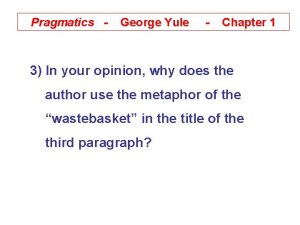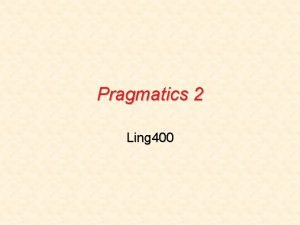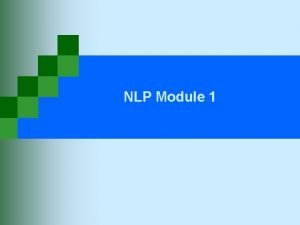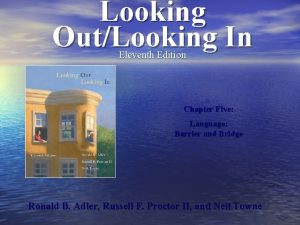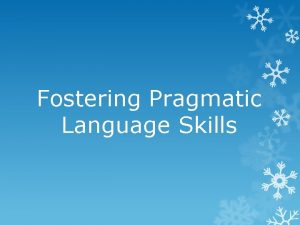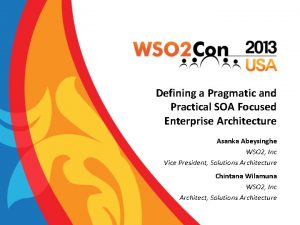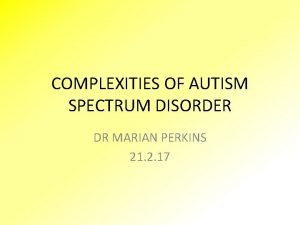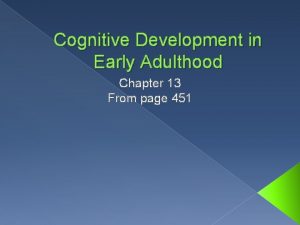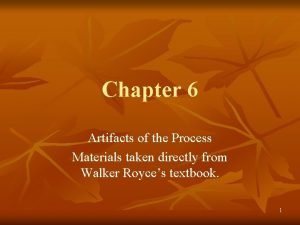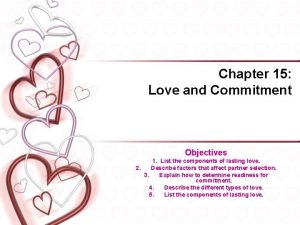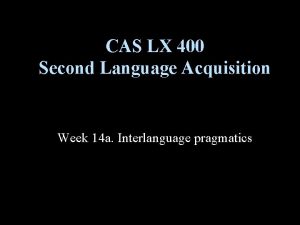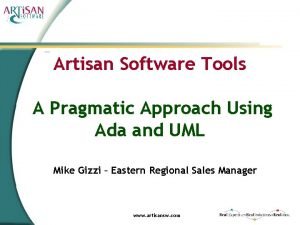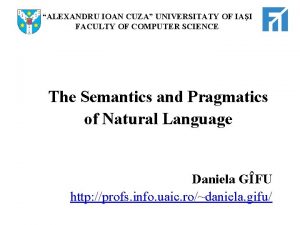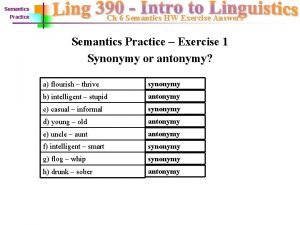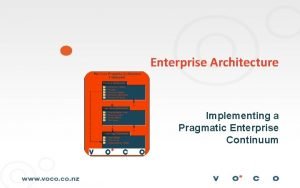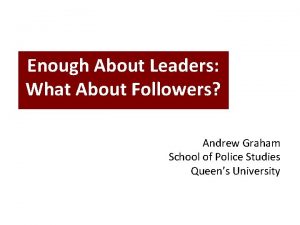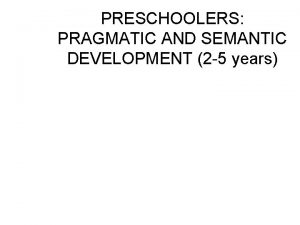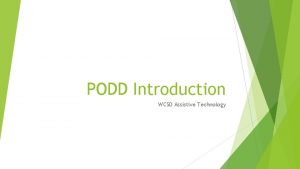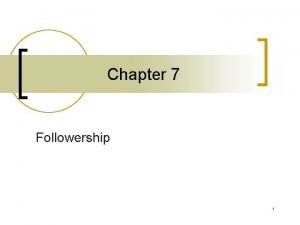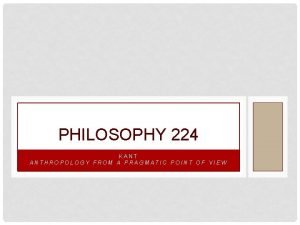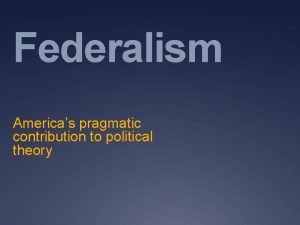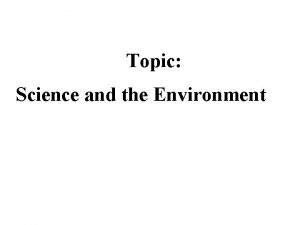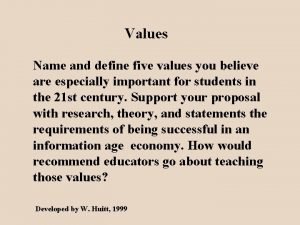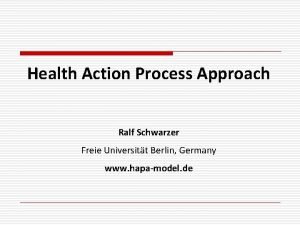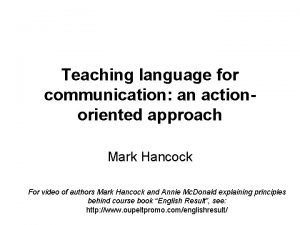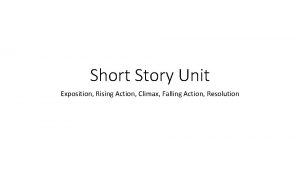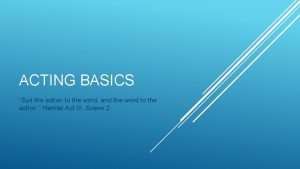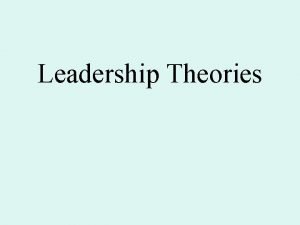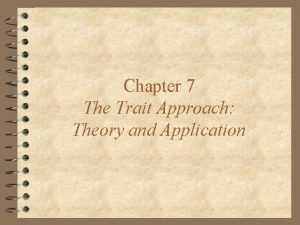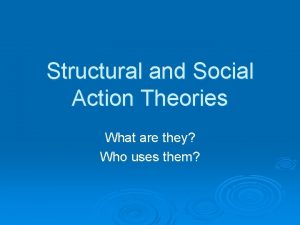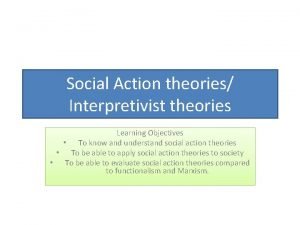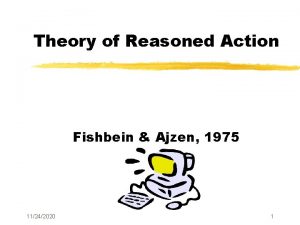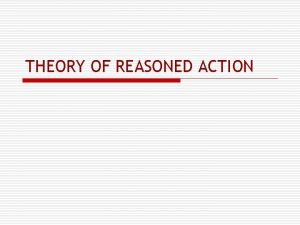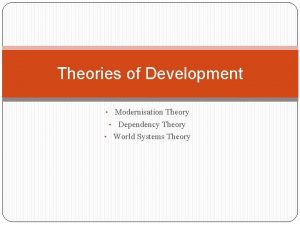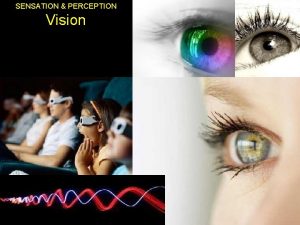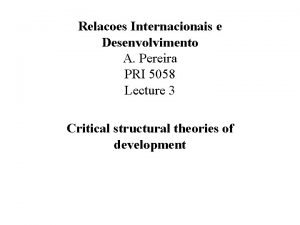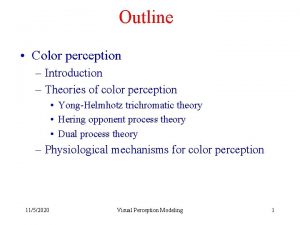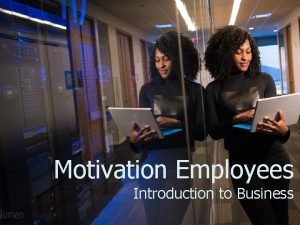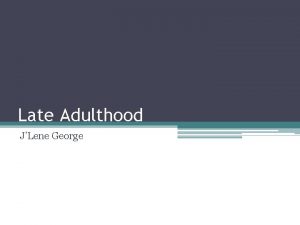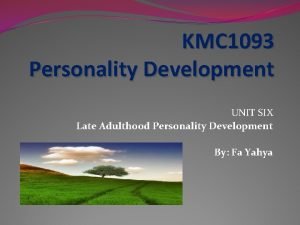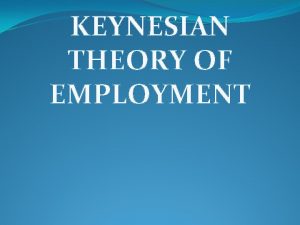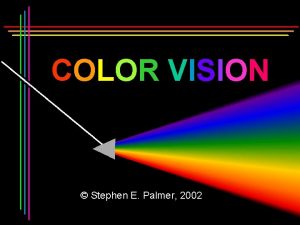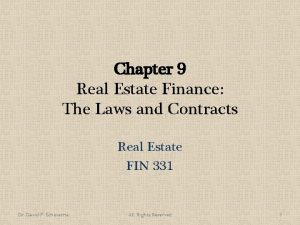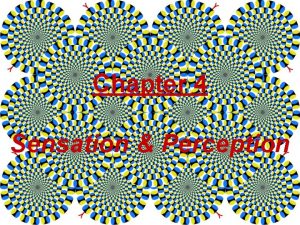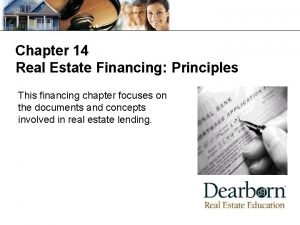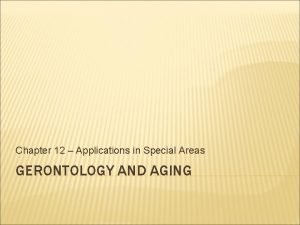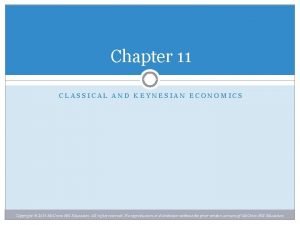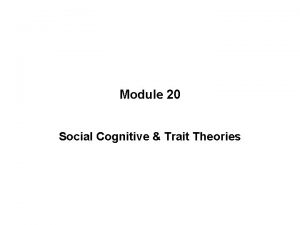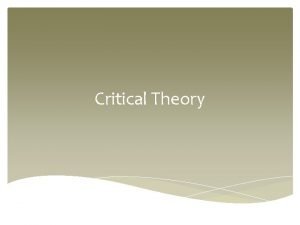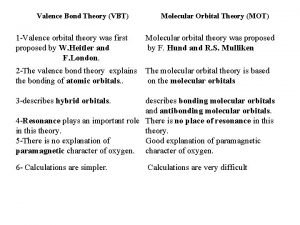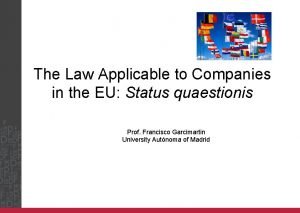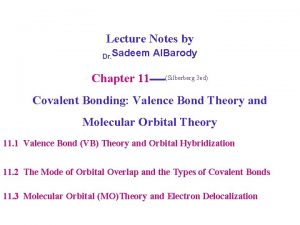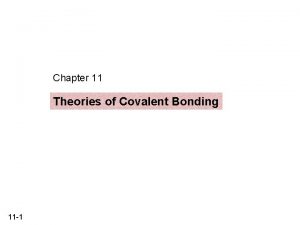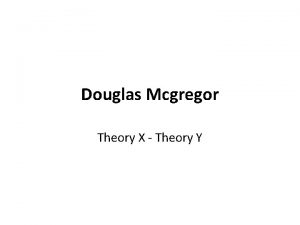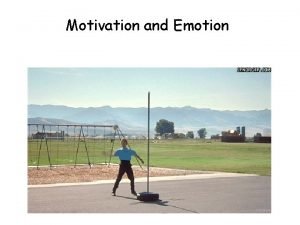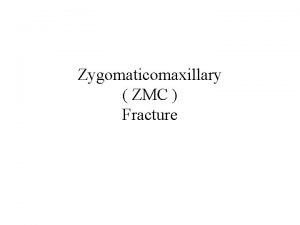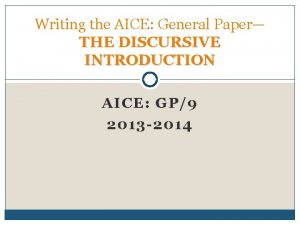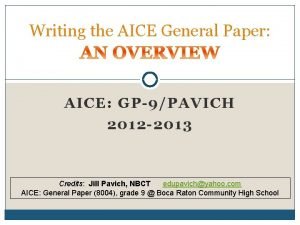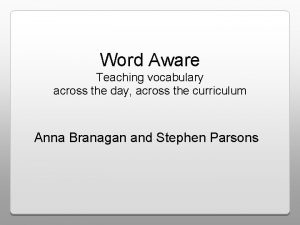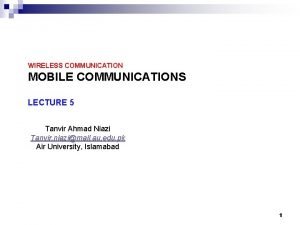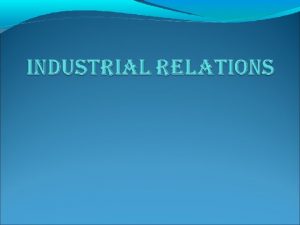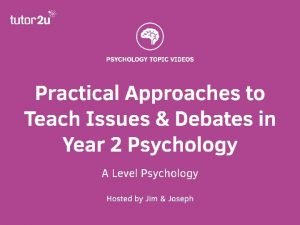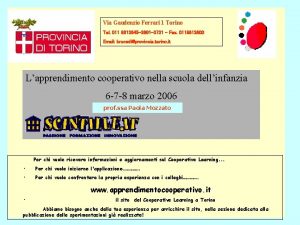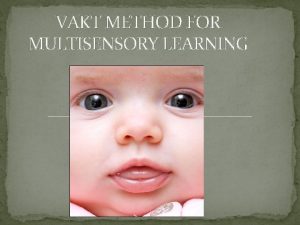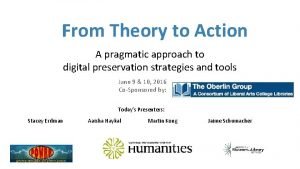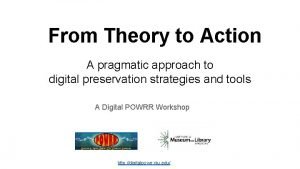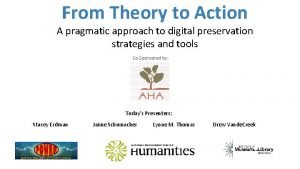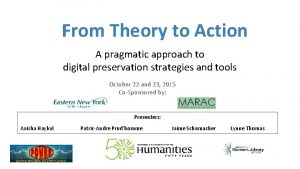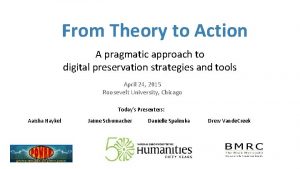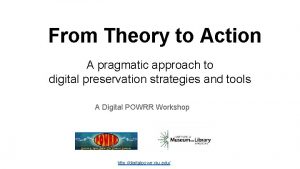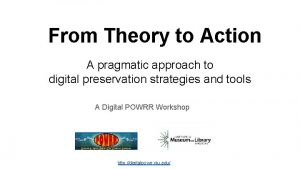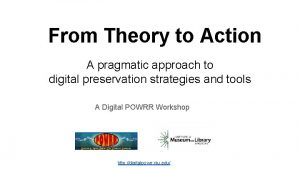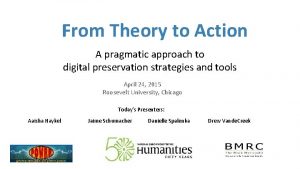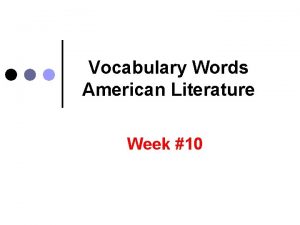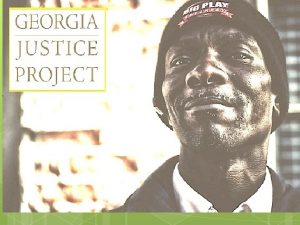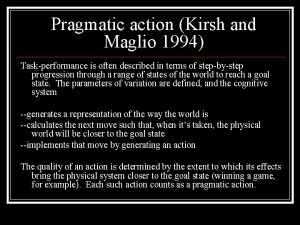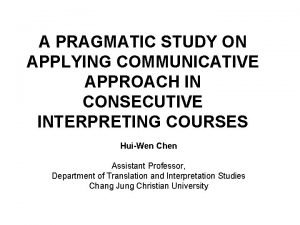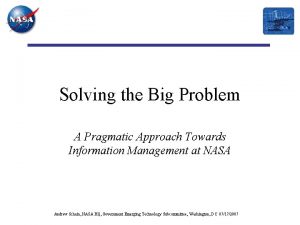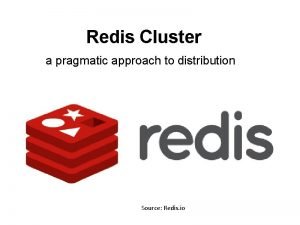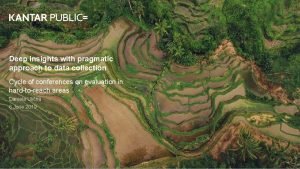From Theory to Action A pragmatic approach to




















































































































- Slides: 116

From Theory to Action A pragmatic approach to digital preservation strategies and tools October 10, 2016 Co-Sponsored by: Today’s Presenters: Jeffrey Hancks Martin Kong Jaime Schumacher Danielle Spalenka

Logistics/Housekeeping • Basic Logistics • Handouts/Flash Drives • Assessment/Evaluation (today and in 3 months) YOUR FEEDBACK IS VITAL - Pre-Test - Post-Test - Standard Workshop Evaluation - 3 Month Follow-up Live Tweeting? @digital. POWRR First Up… The Day’s Schedule!

MORNING Now – 9: 45 Collect Pre-Tests Expected Outcomes Background of POWRR Levels of Preservation (Activity) 9: 45 – 10: 15 Solution in Theory vs. Solution in Practice Your Pre-Ingest Workflow 10: 15 Break 10: 30 – Noon Investigation of Tools and Services AFTERNOON 1: 00 – 2: 30 Solution in Action: Accessioning a Collection (Activity) 2: 30 Break 2: 45 – 3: 15 Policy, Advocacy 3: 15 – 3: 45 Your 3 -3 -3 Action Plan (Activity) Potential Solution Models 3: 45 – 4: 00 Questions Post-Test LUNCH!

Expected Outcomes • You will understand that different digital preservation tools/services can perform different functions within the digital curation lifecycle, and be able to explain how these tools/services can be used within your institution’s workflow. • You will practice the initial pre-ingest steps necessary to accession a digital collection, as described in the OCLC report “Walk this Way, ” and gain the skills necessary to repeat this process at your institution. • You will gain hands on experience with a basic digital preservation tool and understand how it can be used within your institution’s workflow. • You will take away resources that help align communication and advocacy, policymaking, and tool selection/implementation. • You will create a 3 -3 -3 Action Plan to implement in the following 3 months that will move you closer to your digital preservation goals.

In other words… • • • We can investigate potential tools and services We can triage our data for ingest We can upgrade our metadata and recordkeeping practices for the next steps We can build policies and plans We can better educate ourselves, our stakeholders, and our funders

Who we are…. and how we got here…. • Defining Moments Found Some Friends • Applied for Implementation Grant Received a “Figure It Out” Grant Received NEH grant We’ve learned a lot…and are a lot like you! Proud to be works-in-progress: Sponsored By:

Clarification: Preservation vs. Access Long term access (Preservation) Short term access • Purpose: ensure long-term access • Purpose: provide content to users now • Focus: current & future users • Focus: current • Relies on proven (reliable) technologies to preserve digital objects across generations of technology • Relies on cutting edge technologies to provide best and fastest access at a point in time • Accumulates metadata over the life cycle to trace preserved content • Selects metadata needed to use and understand content • Preservation systems create new versions of digital objects for access to deliver as needs change over time • Access systems deliver objects with useroriented services

http: //www. digitalpreservation. gov/ndsa/activities/levels. html

Activity Time! NDSA Levels of Preservation Where can my organization place its Bingo chips? • We’ll go first • Small Groups – Where do you think you fit in? • All Together – Poll of who is where!

So……How do we get from here to there? Solution in Practice Solution in Theory vs. Scary OAIS Spaghetti Monster

Solution in Theory • OAIS (Open Archival Information Systems) and other schematic models • TRAC Certification (Trustworthy Repositories Audit & Certification) • TDR ISO 16363 (Trustworthy Digital Repository ISO Standard) • Curation Lifecycles that don’t look a thing like our current workflows SIPs, AIPs, DIPs, Oh my!

Solution in Practice AKA Good Enough DP for real people!! Our take on what you need to consider when thinking about your digital stuff…. . And a few other odds & ends… Getting it Understanding it & Documenting it Letting people use it …or not! Taking care of it

Our take on some things that need to happen or be considered along the way to this “Digital Preservation” thing…. We used this to understand the myriad of tools and services that are out there by mapping them across this lifecycle. http: //digitalpowrr. niu. edu/tool-grid/

Solution in Practice AKA Good Enough DP for real people!! Some things to keep in mind…. . • Not all tools and services are created equal. - Some tools/services do specific tasks (microservices). - Some tools/services combine multiple microservices (you guessed it…. macroservices!). • Starting small is good enough! • Knowing what you have is crucial. - Write. It. Down. And maintain it!

Actual Conversation, ca. 2004 “I’d like our institution to be the home for your literary papers. ” *gets handed flash drive*

Don’t Panic - Your Pre-Ingest Workflow aka Wrangling your digital stuff before you can get it into a shiny system NOTE: This is only ONE way to do this… Everyone’s workflow is a little different! Yes, it can be as simple as creating a spreadsheet!. Starting from scratch: • Begin an Inventory Spreadsheet • Run accessioning tools (creates basic preservation metadata files in XML for you!) - Move everything to a stable carrier (like a network drive) • Make an Access Copy from your Master Copy • Continue populating Inventory Spreadsheet (if needed) • OPTIONAL: Keep original media ü Most of these will cost you more time than money ü Document what you do pre-ingest. For future you. ü Remember: Good enough is just fine. For now.

Pre-Ingest Inventory Spreadsheet Categories These suggestions follow the recommended DPOE step “Identify” as locally defined by curator/archivist. Example at: http: //www. carli. illinois. edu/sites/files/digital_collections/documentation/digipres_identify. pdf q q q Category (digitization project; born digital; university archives) Title and Description Date(s) (date range of what’s IN there or date of creation if born digital) Location (CD, Jump drive, server location? ) Extent (quantity: 48 journal issues; 106 images; 2 TB of video) Format (file formats: PDF, . Jpeg, Animated GIF, Wordstar 2. 0 file) This is YOUR inventory… YOU get to decide if it needs additional fields, if some can be deleted, etc. You are the boss of this! FILL OUT WHAT YOU CAN AS YOU WOULD WITH ANY NORMAL ACCESSION DPOE is a Library of Congress Digital Preservation and Outreach Program http: //www. digitalpreservation. gov/education/

BREAK TIME! Back by 10: 30, please Next up: Tools and Services Live Tweeting? @digital. POWRR

Let’s Talk About Tools…. *Tools/Services in RED were tested in-depth by POWRR There are front-end/processing tools like…. . Archivematica Curator’s Workbench Data Accessioner Bit. Curator And there are back-end storage/preservation services like…. . Meta. Archive Dura. Cloud Amazon Glacier Fixity Internet Archive There are even some services that will pretty much do it all like…. Preservica Dspace Direct (uses Dura. Cloud) Archives. DIRECT Note: Yes, there also CMS’s, IR software, …. ugh. However, these are outside the scope of this workshop! Technical skill available + amount of annual funding devoted to DP = range of tools you will be considering

A note about the word “free” NOT Open source software requires resources to install, maintain, and improve it.

Front-End / Processing: Data. Accessioner

Front-End / Processing: Data. Accessioner • Open source/free software • Microservices only run when you use the program • Requires no IT support – very easy to use • Raw XML output can be hard to read – need to use another tool (i. e. Data Accessioner: Metadata Transformer) to view in spreadsheet/HTML form • Simplicity has limitations – needs to be used with other tools • Can be a slow process if working with bigger collections • Capability to manually add own descriptive metadata • Identifies, validates, and extracts technical metadata for wide range of file formats • Runs on FITS toolset (12 different tools) • Migrates and makes a copy of digital objects

DEMO!

Back-End / Preservation: Fixity

Back-End / Preservation: Fixity • Open source/free software • Requires little IT support • Simple interface – easy to use • Automated – scheduled checks, e-mails alerts and reports • Designed with small-medium sized collections in mind • Great documentation, tutorials, and support • Creates a manifest of files • Monitors file integrity • Works well with other tools like Bag. It

Fixity: Save New Project

Fixity: SMTP Settings

Fixity: Report

Front-End / Processing: Bit. Curator

A Note on Digital Forensics • Generally refers to the process of recovering, analyzing, and reporting on data found on digital devices • Used to collect trustworthy evidence, through the extraction of data from devices and media, to pinpoint crimes/misconduct/security breaches Parallels with archives include providing accurate record of chain of custody, documenting provenance, and storing data in ways that resist tampering/loss •

Front-End / Processing: Bit. Curator • Supported tasks include: ü Disk image creation ü Data triage: analyze files/file systems, locate/remove duplicate files ü Extract file system metadata ü Identify and redact sensitive info • Ensures authenticity, integrity, and provenance of digital material transfers • Open source/free software • Requires IT support (Virtual Machine or Linux environment); bootable USB version also available for download • Great support, documentation, and tutorials: http//: wiki. bitcurator. net • External peripherals (i. e. floppy drives) can be used, but require extra support • Access component coming soon (Bit. Curator Access) • Hardware write-blocker also recommended

Creating a Disk Image: Guymager

Generating a Checksum: Nautilus

Generating a Checksum: Nautilus

Front-End / Processing: Archivematica

Front-End / Processing: Archivematica • Open source/free software • Integrates with Content DM & DSpace • Requires IT support and administration (Virtual Machine, Ubuntu Server, etc. ) • Bundled with ICA-ATo. M (archival content management system like ARCHON) • Microservices run by themselves • Hosted version now available • File transfers not intuitive • Slower processing, but that could be due to the fact that we are used to desktop-based applications • • Shows all the steps for AIP, SIP, DIP Capability to upload own metadata • Errors stop everything • Great Google users group support

Archivematica: Transfer Collection

Archivematica: Normalization On Ingest

Archivematica: Add Metadata

Archivematica: Add AIP to Storage

Back-End / Preservation: Dura. Cloud

Back-End / Preservation: Dura. Cloud • • Nonprofit; Open Pricing; Community buy-in Cloud storage/preservation solution • Easy exit strategy • Integration with DSpace • New: Integrated with hosted version of Dspace • Different storage provider options • Hosted service (requires little to no IT support on your end!) • Media streaming based on Amazon’s Cloud service • Some microservices available (like health checks that verify checksums) • Responsive customer service with very good documentation • Different options/methods for uploading content (bulk, single item, etc. ) • Affordable; Scalable; Easy to get started • Intuitive uploads and file management







Full Lifecycle: Archives. Direct


Full Lifecycle: Preservica

Full Lifecycle: Preservica All encompassing: - Ingest - Processing - End-User Access - Preservation - Migration • Ability to harvest via web crawls • Solid customer support • Different training options available for institutions with smaller budgets • Aligned with OAIS reference model • Currently uses only Amazon cloud storage - new options forthcoming • Hosted Service (Requires little IT support on your end) • Proprietary, vendor-based • Very user friendly • E-mail Preservation • Intuitive workflows • Exit strategy available (batch export) •




INGEST






Back-End / Preservation: Meta. Archive

Back-End / Preservation: Meta. Archive • Nonprofit; Open Pricing • Assumes pre-processing work is done • Instant community in the Cooperative! - All the cool kids are doing it! • Rules for minimum processing requirements (ie file naming conventions) • Helpful and responsive customer service http: //www. metaarchive. org/costs • Private LOCKSS network • Dark Archive • Requires dedicated IT administration • Most memberships require attending meetings What we tested

Back-End / Preservation: Meta. Archive Very simplified version of how it works: Collaborative Membership Model Meta. Archive AIPs 2) Lead Institution prepares a staging server, sets appropriate access protocols and assists Partners with technical help. Tech Help Lead Institution AIPs via FTP 3) Partners FTP their AIP’s (Bags) to the staging server at the Lead Institution. We used Filezilla Staging Server LOCKSS Server Tech Help Partner 1 Partner n Partner 2 1) Partners prepare their content for preservation and package it. We used the Bag. It specification, and Bagger helped us with this 4) Meta. Archive harvests the AIP’s from the Lead Institution's staging server and pushes it into their LOCKSS network. One other thing: The Lead Institution also has a dedicated server that runs the LOCKKS software, is hooked into the Meta. Archive network of servers across the globe, and is actively preserving the content of other Members.

Back-End / Preservation: Amazon Glacier

Back-End / Preservation: Amazon Glacier • Long-term, deep storage • Cloud storage • Good for large or growing collections • Data stored is redundant across multiple Amazon data centers • Pay-as-you-go pricing model • Easy to retrieve information back but will cost you if you need it back quickly • Visibility into fixity checking not available to clients • Data management is limited



Full Lifecycle: Internet Archive X

Internet Archive • Intended for materials to be available to everyone (public domain, CC license) • Geographically distributed copies. • No frills (and no charge!) service. • Can text, audio, video, and images. • Good option for small institutions with limited (or no) other alternatives. • Does offer a more robust preservation product through its Archive-It service (web archiving only).


POWRR Q&A X

Some other things to consider… Web Archiving E-mail Archiving • What’s good? Well, we’re making progress! • • • Process of collecting portions of the world wide web to ensure information is preserved in an archive for future researchers. Requires special software for capture and use Typically employ “web crawlers” for scheduled, automated capture Web ARChive format (WARC) is now an ISO Standard, used by LOC, de facto preservation standard • Open source solutions from trusted institutions • Establishing archival standards – MBOX and EML What’s scary? • Proprietary software • Formats within formats • Maintaining conversational threads • SC AL E

PROGRESS!! ü We can investigate potential tools and services We can triage our data for ingest We can upgrade our metadata and recordkeeping practices for the next steps We can build policies and plans We can better educate ourselves, our stakeholders, and our funders

LUNCH

Solution in Action: Accessioning a Collection Activity Time! 1 – 2: 30 pm • Hypothetical Donation • Pre-Ingest Workflow • Inventory • Triage with Data. Accessioner • Visualizing the output with Data. Accessioner: Metadata Transformer Tool • Monitoring long-term health with Fixity • Making decisions about preservation

Don’t Panic - Your Pre-Ingest Workflow aka Wrangling your digital stuff before you can get it into a shiny system NOTE: This is only ONE way to do this… Everyone’s workflow is a little different! Starting from scratch: • Begin an Inventory Spreadsheet • Run accessioning tools (creates basic preservation metadata files in XML for you!) - Move everything to a stable carrier (like a network drive) • Make an Access Copy from your Master Copy • Continue populating Inventory Spreadsheet (if needed) • OPTIONAL: Keep original media


Live Demo of Data. Accessioner and DA: MT


Your Turn! Insert flash drive and open the explorer window Digital POWRR Workshop Tools and Hands On Activities Data Accessioner Data. Accessioner_v 1_0 -beta Navigate to Data. Accessioner. jar and open it

Create your accession directory: Where you want the collection to go live Preferably a stable media like your network drive In your POWRR drive, open the New. Accessions folder and select the Master Copies folder

Select the collection you are accessioning

Populate descriptive metadata and migrate your collection Select which element you want to add metadata to Add the Dublin Core Metadata goes here Hit the “Migrate” button to begin the migration process. You will be able to see the progress bar move at the bottom.

What did you create? New copy of your migrated collection. Located in the Directory that you specified XML Metadata file You. Are. AWESOME.

Not quite finished… Make a copy of the Master, place in the Access Copies folder, and don’t touch the Master Copy again unless a new derivative is needed or until you move it into a preservation system!!

And finally…update your Inventory to reflect the location of the Access Copy. Note addition of XML file after processing.

DA: Metadata Transformer Navigate to DAMetadata. Transformer. jar and open it Click on “Add DA Metadata” button

Navigate to the XML file you just created. We also want a place where the new reports will go live. In this case, you can create a “Reports” folder You will see the XML created and the folder where the new reports will go live. Click on “Generate Reports”

Once the reports have been generated, DA: MT will show the results. In this case, two files were created: a CSV file and HTML file. To view the files, navigate back to the “Reports” folder.

CSV FILE Tell me more!

Fixity Video & Demo digitallypowrr@gmail. com Digipowrr

Courtesy of: Tawnya Keller, Digital Preservation Archivist University of Utah

PROGRESS!! ü ü ü We can investigate potential tools and services We can triage our data for ingest We can upgrade our metadata and recordkeeping practices for the next steps We can build policies and plans We can better educate ourselves, our stakeholders, and our funders

BREAK TIME! Back by 2: 45, please Policy & Advocacy Your 3 -3 -3 Action Plan (Activity) Potential Solution Models

Outside Your Office Digital Preservation is not sustainable by just using a tool or selecting a service. Sustainability takes funding and people. Three-Legged Stool of Digital Preservation You cannot do this alone. You will need to talk to other people… because you are not the only boss of this. Successful Digital Preservation programs take a team of people at multiple administrative levels. Anne R. Kenney Nancy Mc. Govern Digital Preservation Management Workshop http: //www. dpworkshop. org/

Jump In! What actions can you take today to move forward? Image: Flickr Commons

Policy Electronic records are outside the scope of preservation committee. There isn’t a budget line for that! I’m the only one here.

What do we do now? Where would you ideally like to be? What is keeping your institution from moving in that direction? What are some interim steps you can take to move in the right direction?

Image: Flickr Commons

Policy A Gap Analysis • Be brutally honest. It’s the only way to move forward. • What is the risk of doing nothing? • Documenting what you know will tell you what you don’t know. • Feel free to look at our case studies and see how it worked. Our wiki has the case studies of all 5 of the POWRR partner institutions. http: //powrr-wiki. lib. niu. edu/index. php/Main_Page

Advocacy • Advocacy is valuable because you’re educating people about why digital preservation is also THEIR problem. There’s a hiring freeze on campus. All that’s just on the Internet, it’ll always be there. We can’t even afford test tubes for CHEM 101!!

MORE PROGRESS!! ü ü ü We can investigate potential tools and services ü ü We can build policies and plans We can triage our data for ingest We can upgrade our metadata and recordkeeping practices for the next steps We can better educate ourselves, our stakeholders, and our funders


Activity Time! Small Groups: Who should care about DP? Why? 1. List the roles/titles of all those who should be involved with, and care about, digital preservation at your organizations. 2. Make a list of potential consequences—what will happen if your colleagues don’t take action? What is at risk of loss if no digital preservation program is created?

On Your Own: Your 3 -3 -3 Action Plan List 3 specific people at your organization with whom you can make contact …. . …and 3 digital preservation activities to which you and your team can commit…. …. in the next 3 months! Who What When Pat Graham (Dean) Coffee debrief 2 weeks Cathleen Debose (Metadata Librarian) Mapping metadata, functional requirements 3 months Taylor Gibbs (Museum Executive Director) Policy review 2 months

Examples of Initial DP Activities Advocate Research - Awareness-raising meetings - Brownbag presentation Identify - Compile a digital content inventory - Analyze file formats used - Analyze metadata practices - Review current policies - Diagram current workflows - Investigate tools - Review other institutions’ policies - Read the POWRR white paper - Survey staff on existing practices Update - Enhance existing metadata - Add digital content to policies - Produce digital preservation plan

In 3 Months… How will you know if your 3 activities succeeded? • Added people to team? • Number of people newly educated? • Number of items added to inventory? • Number of tools investigated? • Number of DP policies reviewed? • Revised standing policies?

From Theory to Action: Solution in Practice is Iterative • Starting small is good enough! A simple tool may still move you closer to your goals. • Not all tools and services are created equal. • Choices of tools are not forever. They serve what you need now, selected with an eye to later. • Knowing what you have is crucial. Documentation more so. • You already have many of the necessary skills!

How to Decide? Results May Vary… Things to consider: • How many staff members will be actively engaged in the digital curation lifecycle? Are they tech-savvy? • How robust and supportive is your technical/systems group? Do you even have one? How about some developers/programmers…have any of those on staff? • Does your organization already use archival management software or an Institutional Repository (like ARCHON/Archives. Space, Be. Press, Fedora etc. )? Consider selecting tools/services that work well with what you have. • Do you have digital collections unique to your institution that are irreplaceable? Consider organizing collections along the lines of those that warrant more robust preservation than others. For example: 1 TB (High Value) 3 TB (Medium Value) Rest (Replaceable) Meta. Archive (gold standard) Amazon Glacier (cheapest storage with fixity checking) Tape Drive Backups In other words: One tool/service may not be your only solution.

How to Decide? Results May Vary… Remember: Smaller institutions with less resources may also have unique advantages like…. It doesn’t take years to set up an account with something like Dura. Cloud. You only need to convince the person one level above you to get what you need. • Less red tape for getting things done Want to install a simple open source tool? Go for it! • Fewer levels to push requests for additional resources through • Self-administered workstations (aka no IT administrative lock downs) • Personnel-heavy operating model (usually has smaller cash flow) • Higher cash flows and less data (like small, private institution) This is ideal for running a *free* robust tool that requires a developer and server administrator like Archivematica. You can purchase a reasonably-priced, hosted soup-to-nuts solution.

Potential Solution Models POWRR White Paper available at: http: //commons. lib. niu. edu/handle/10843/13610

Wrapping Up Our Final Thoughts & Your Questions I survived the POWRR workshop! Now what? http: //digital. POWRR. niu. edu/survived-powrr-wkshp/ We’re here to help. Seriously. YOU CAN DO THIS. Really. But not alone. So bring some friends. “If you want to go fast…go alone. If you want to go far…go together. ” — African Proverb Remember: Baby steps still move you forward!

Evaluation Time! (10 minutes) • Post-Test • Workshop evaluation…tells us about pace, style of presenting, etc. In 3 Months… • Emailing you a brief survey around your 3 -3 -3 Action Plan • Google Hangout? Slack? Please note: The NEH requires us to do these things…and it helps to make sure these workshops are delivering outcomes that bring tangible results to our peers!

Thank You for Coming! PLEASE RETURN: • Pre & Post Tests • Workshop Evaluation

POWRR Project Team Members Contact us…we are here to help! Northern Illinois University Lynne M. Thomas Head, Distinctive Collections; lmthomas@niu. edu Drew Vande. Creek drew@niu. edu Director Digital Scholarship Chicago State University Aaisha Haykal University Archivist anhaykal@gmail. com *Martin Kong Systems Librarian martinkong 2@gmail. com *Jaime Schumacher Scholarly Communications jschumacher@niu. edu Librarian Illinois State University *Danielle Spalenka powrr@niu. edu Illinois Wesleyan University Meg Miner University Archivist mminer@iwu. edu Beloit College Stacey Erdman erdmansn@beloit. edu * Presented today Digital POWRR Director Digital Archivist Patrice-Andre Prud’homme Digital Collections Head ppprudh@ilstu. edu Western Illinois University *Jeff Hancks Director, Archives and jl-hancks@wiu. edu Special Collections
 Pragmatic approach in accounting theory
Pragmatic approach in accounting theory Pragmatic approach to problem solving
Pragmatic approach to problem solving Correspondence theory of truth
Correspondence theory of truth Time of knowledge
Time of knowledge Pragmatism theory of truth example
Pragmatism theory of truth example Forms of love
Forms of love What are the 4 cueing systems in reading
What are the 4 cueing systems in reading The difference between pragmatics and discourse analysis
The difference between pragmatics and discourse analysis Semantics vs pragmatics
Semantics vs pragmatics Locutionary, illocutionary and perlocutionary acts examples
Locutionary, illocutionary and perlocutionary acts examples Yule pragmatics
Yule pragmatics Implicature and entailment
Implicature and entailment Pragmatics examples
Pragmatics examples Language
Language Pragmatic language
Pragmatic language Aliran sociological jurisprudence
Aliran sociological jurisprudence Wso pragmatic
Wso pragmatic Social pragmatic communication disorder vs autism
Social pragmatic communication disorder vs autism Early adulthood cognitive development
Early adulthood cognitive development Pragmatic artifacts in software project management
Pragmatic artifacts in software project management Pragmatic love
Pragmatic love Cognitive development during early adulthood
Cognitive development during early adulthood Pragmatic rules
Pragmatic rules Aspects of lexical meaning
Aspects of lexical meaning Artisan software tools
Artisan software tools Pragmatic definition in linguistics
Pragmatic definition in linguistics Semantle answers
Semantle answers Pragmatic enterprise architecture
Pragmatic enterprise architecture Kellerman followership model
Kellerman followership model Semantic development examples
Semantic development examples Pragmatic organization dynamic display
Pragmatic organization dynamic display Critical and uncritical thinking
Critical and uncritical thinking Pragmatic synonym
Pragmatic synonym Immanuel kant philosophical view of self
Immanuel kant philosophical view of self Pragmatic federalism definition
Pragmatic federalism definition Pragmatic agnosticism
Pragmatic agnosticism Pragmatic utilitarian conservation
Pragmatic utilitarian conservation Improving software economics geeksforgeeks
Improving software economics geeksforgeeks Apathetic (pragmatic) agnosticism
Apathetic (pragmatic) agnosticism Datagram approach
Datagram approach Theoretical models of counseling
Theoretical models of counseling Country attractiveness matrix
Country attractiveness matrix Multiple approach avoidance conflict
Multiple approach avoidance conflict Bandura's reciprocal determinism
Bandura's reciprocal determinism Definition of research approach
Definition of research approach Diagram for traditional approach
Diagram for traditional approach Deep learning approach and surface learning approach
Deep learning approach and surface learning approach Action learning approach in values education
Action learning approach in values education Ralf schwarzer
Ralf schwarzer Language
Language Chronological sequential in medias res flashback
Chronological sequential in medias res flashback Exposition plot
Exposition plot Stages of a plot
Stages of a plot Short story with exposition
Short story with exposition Suit the action to the word the word to the action meaning
Suit the action to the word the word to the action meaning Approach style
Approach style Trait approach theory
Trait approach theory Action assembly theory examples
Action assembly theory examples Social action theory examples
Social action theory examples Strengths and weaknesses of social action theory
Strengths and weaknesses of social action theory Sofiasynergy
Sofiasynergy Fishbein ajzen 1975
Fishbein ajzen 1975 Theory of reasoned action adalah
Theory of reasoned action adalah Reasoned action theory adalah
Reasoned action theory adalah Living educational theory
Living educational theory Theory x and theory y
Theory x and theory y Plate tectonics vs continental drift
Plate tectonics vs continental drift Wallerstein's world systems theory
Wallerstein's world systems theory Sensation
Sensation Criticism of dependency theory
Criticism of dependency theory Continental drift vs plate tectonics theory
Continental drift vs plate tectonics theory Describe the trichromatic theory of color vision.
Describe the trichromatic theory of color vision. Neo classical organizational theory
Neo classical organizational theory Motivation in group formation
Motivation in group formation Hawthorne motivation
Hawthorne motivation Continuity theory vs activity theory
Continuity theory vs activity theory Conclusion of adulthood
Conclusion of adulthood Keynesian and classical theory
Keynesian and classical theory Opponent process theory vs trichromatic theory
Opponent process theory vs trichromatic theory Theoretical plates
Theoretical plates Lien theory vs title theory
Lien theory vs title theory Opponent process theory vs trichromatic theory
Opponent process theory vs trichromatic theory Title theory and lien theory
Title theory and lien theory Continuity theory vs activity theory
Continuity theory vs activity theory Three ranges of the as curve
Three ranges of the as curve Theory x and theory y
Theory x and theory y Social cognitive personality
Social cognitive personality Neoclassical growth theory vs. endogenous growth theory
Neoclassical growth theory vs. endogenous growth theory Game theory and graph theory
Game theory and graph theory Conflict critical theory
Conflict critical theory Mot of no
Mot of no Pz and dxz overlap
Pz and dxz overlap Legal status of company
Legal status of company Theory x and theory y
Theory x and theory y Valence bond theory and molecular orbital theory
Valence bond theory and molecular orbital theory 11:55
11:55 Valence bond theory
Valence bond theory Douglas mcgregor theory x and y
Douglas mcgregor theory x and y Heliocentric theory vs geocentric theory
Heliocentric theory vs geocentric theory Instinct theory of motivation
Instinct theory of motivation Zmc anatomy
Zmc anatomy Aice general paper discursive essay
Aice general paper discursive essay Aice general paper rubric
Aice general paper rubric Parsons word aware download
Parsons word aware download Cell dragging in wireless communication
Cell dragging in wireless communication Wid wad and gad approaches
Wid wad and gad approaches Qualitative research
Qualitative research Jt dunlop
Jt dunlop Per capita income formula
Per capita income formula Unit cost meaning
Unit cost meaning Personality definition
Personality definition Is chalk natural or manmade
Is chalk natural or manmade Tutor2u psychology relationships
Tutor2u psychology relationships Approach aggressively
Approach aggressively Via gaudenzio ferrari 4 torino
Via gaudenzio ferrari 4 torino Vakt method
Vakt method Solihull approach triangle
Solihull approach triangle
